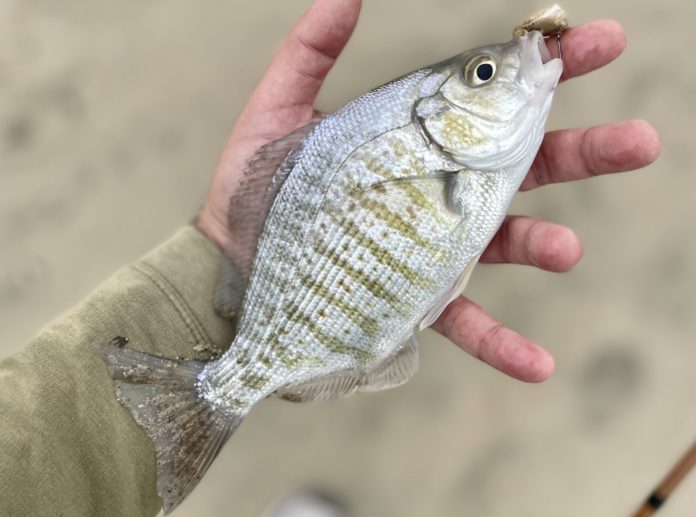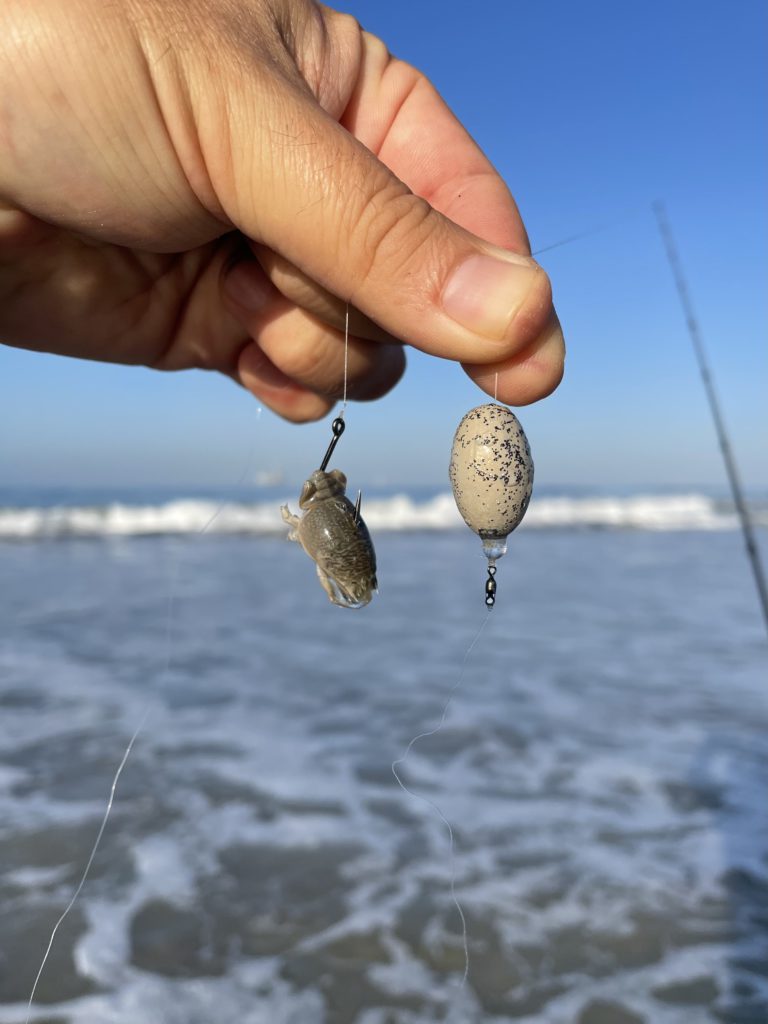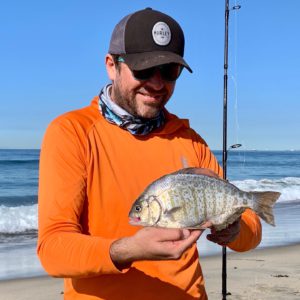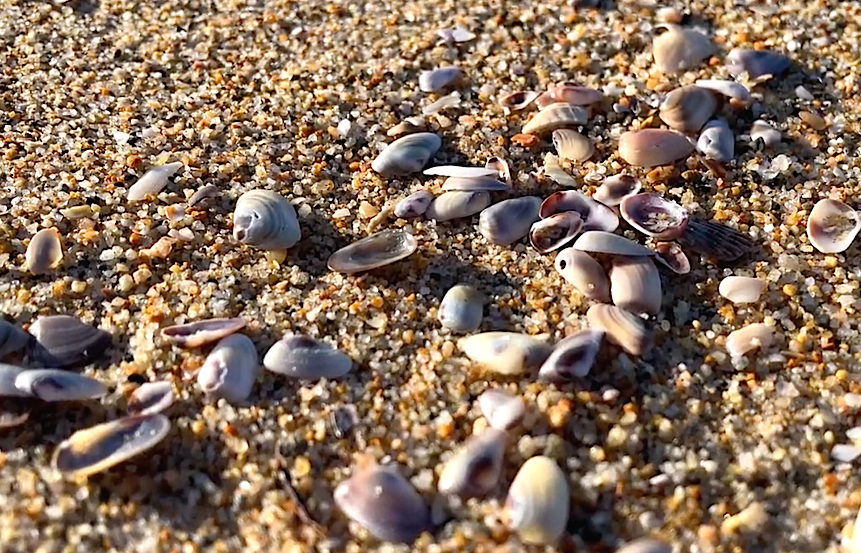
BY BEN HERVEY-MURRAY
One of my favorite West Coast fishing missions involves chasing surfperch on light tackle from the beautiful beaches of Southern California. The challenge of finding, hooking and landing a proper slab whilst the waves are crashing around your knees and the sun pokes through the mist is addictive, but it can also be infuriating as members of the surfperch family have some very particular behaviors and preferences that are useful to know about.
So, let’s run through some key lessons I’ve learnt over the past few years, both through my own fishing and by helping many guided clients nab their first or PB perch. I’ve boiled these tips down to five major areas where I think most people can look to if they want to catch surfperch on light line, or improve their chances of a busy day dramatically.
I’d like to acknowledge that the nature of surfperch fishing does change as you work your way up the West Coast. The further north you go, the more energetic the surf tends to be and tactics change accordingly. For example, tackling surfperch in Central California and above usually requires a heavier bait-and-wait or lure-based approach due to the more testing nature of the beaches and different feeding patterns.
The fish tend to be a bit bigger, too. The species are also subtly different with barred and walleye surfperch dominating southern counties whilst larger calico and redtail varieties keep anglers further north busy. For the purposes of this article, I’ll assume you’re tackling a sandy beach with some rocks nearby, with an average swell and current and a good chance of a few perch being home and hungry using grubs or sand crabs.
For more detailed background information on surfperch I strongly suggest you check out Nick Heid’s extremely thorough exploration of the species in Western Outdoor News in his excellent Full Bend column, November 26 issue. In the meantime, let’s get into the gritty details of chasing surfperch on light tackle this winter and where you might be going wrong.
You’re fishing too far out
Do you know what the biggest, most obvious feature on a beach is? The one that’s holding

90% of the food and a majority of the surfperch? It’s staring you in the face, literally, or you’re treading on it. I’m talking about the shore break lip – that first little ridge of broken shells and detritus that sits just off the wet sand in a foot or two of water where that last breaker turns over and churns up the bottom. There’s often a subtle ditch-type structure running parallel to this ridge too.
Most beaches have this kind of feature and this is where a majority of the perch will be feeding, assuming the tide is some way up from a low, probably an hour or two either side of the high tide. This is my preferred state of tide for surfperch, by the way, and if it coincides with dawn or dusk, then even better. Big barred mammas in particular will move up the beach to feast using this change in light, moving water and availability of fresh food turned over by the high tide.
When I describe this quirk of surfperch fishing to a newbie (that they can be caught almost under your feet), I can understand their mild disbelief: “You want me to fish there?” To our human eye, living and feeding in the churn of the shore break in a foot or two of water doesn’t compute. Fishing there seems insane, but it’s really not.
I promise you that on a standard flat sandy beach, that first ridge structure is surfperch city and they will come so close in you won’t believe your senses when you get a bite. I have a GoPro video of myself hooking a perch in just such a shallow water scenario, with the fish feeding so close to the beach that the act of setting the hook was enough to beach it. This happens frequently. I love it when a client hooks a fish this close in because it proves to them that the fish are feeding there, which means that on their next session they’ll be able to take advantage of this quirk to catch more, too.
This inside ridge feature, for reasons that we will explore properly later on, becomes increasingly important as the winter draws in and the California sand crab population disappears. I promise that your ability to effectively ID and fish this kind of feature will pay increasing dividends as the season progresses. Of course, explore the surrounding structure (rocks, troughs, gullies, holes etc) via a few longer casts, but working that churned-up area closest to shore and especially that little ridge is key. When you find a group of fish working that shore break area, it’s easy to string together several perch on the bounce.
Hooks and sharpness really matter
The type of hook you use really matters because perch do not have a big mouth and the items the usually feed on are small; sandcrabs, tiny worms, finger-sized bait fish and so on. So, using a big J hook stacked with lots of bait may result in some hook-ups, but going for a subtler pattern in the size 4 to 2 range and less bait bulk will get more bites and more fish on the sand.

A common pattern I see in use are baitholder style with the little metal nicks on the hook shank to hold the bait on. Often supplied ready-tied to mono, these are usually pretty crude hooks made from thick wire and they lack any real sharpness. How sharp the hook is matters because perch have tough mouths and penetrating the boney surface is helpful if you want to a photo of your new PB, rather than a good lost fish story.
By the way, I check my hook point every few casts by running it along a fingernail; if it scores the nail easily or catches on the skin like it’s sticky, that’s still a good hook. If it skates over or doesn’t catch the skin, the point is likely turned over on a small rock or stone and won’t penetrate a boney mouth. Re-tie straight away. If I lose a fish, I check the point too. Often, you’ll find the hook will blunt over the course of a session as tough-mouthed perch are dealt with and the point’s ability to find a solid hook hold is decreased. Again, re-tie if you suspect this. Rockier, stonier beaches also kill hook points fast.
I experience some disbelieving clients when it comes to how careful I am over hook points and sharpness. I even carry a jeweler’s eyeglass – known as a loupe – to show my clients what a dulled hook point looks like and to check my own hooks. Many admit that they’d just leave it and recast. I then ask them if they’d like to be attached to their PB perch with a sharp hook, or a very sharp hook. The answer is obvious. Attention to details like these are really important and often make the difference between an OK day and a great day’s sport on the beach.
My overall personal preference for surfperch hooks for bait and grub fishing are the Owner Mosquito Light in size 8, 6, 4 or 2, and in red if you can find them. I find these to be the perfect gauge of wire for landing even the biggest surfperch and they’re super sharp straight out of the packet. Small models down to size 6 or 8 are great for surfperch in the summer when sandcrabs are common; a small bunch of pea-size crabs beats a couple of grape-sized specimens on the hook, in my experience. A size 4 or 2 works well with a small artificial grub or small bits of shrimp, clam or mussel meat during the winter months.
Modified grubs for more hook-ups
The go-to bait for a lot of surfperch anglers is the humble Gulp! Sandworm with the favorites being the 2-inch camo nereis and new penny colors (great in low light), or sections from the longer 6-inch grubs in the same colors. I love these baits because they’ll work all year round and can be kept in a pocket or tackle bag for months without compromising their effectiveness. Similarly-sized grubs for crappie and trout fishing also work well in motoroil, pumpkin and dark red shades, but come without the magic Gulp! juice. This is easily solved: just add a few of your favorite non-Berkley grubs to the packet and let them soak too.
There are a few ways how I use these small grub baits that I think give the angler a greater advantage, starting with the size of the bait. A common mistake is to go for too big a bait when surfperch fishing, assuming you want to catch a range of sizes and you’re not singularly targeting a giant.

For me, even a whole 2-inch bait looks fairly sizeable against a perch’s mouth, let alone a 3- or 4-inch section from a bigger bait. If you look at the shape of the bait and, assuming you’re rigging it with the hook bend protruding about 1/2 to 2/3 of the way down the worm, the average perch would have to eat it in a fairly particular way to get legitimately hooked up.
Of course, you’ll get hook-ups from smaller fish on larger grubs, a big ball of giant sandcrabs or hunk of mussel meat, but I would speculate that this will be in part due to the unfortunate perch eating that exact section of the bait with the hook in, rather than the whole bait entering the mouth and you setting the hook on the first one that really finds it.
I really want to be offering the perch a single mouthful – an on-the-go-snack, if you like. Like a person choosing a small piece of candy to pop into their mouth in one go, I want that bait to be entering the perch’s mouth with the least resistance possible so the hook goes in too. As I tell my clients: feed them a single yummy chicken nugget, not the whole chicken. You want to offer a bait that the fish doesn’t even need to think about eating; the perch just finds it and engulfs it in one go.
So, modifying my baits is something I do a lot to achieve the perfect-sized offering. I rarely start fish a whole 2-inch grub. I snip off the head section to leave a slender inch or so that just covers the hook with a little tail. This retains the highly-effective color, scent and feel of the worm without the issues of a larger bait and small-mouthed fish. This little grub catches everything from palm-sized babies to the giant mammas, which is great if you want a busy day’s fishing and double figures of fish on the sand. Also, if you dig up an average sandworm from beach, most are small and skinny, not big and fat. Match the hatch with your hook bait for maximum action.
Another tip that I believe makes a difference is engineering the side of the bait that appears to the fish first. With particular reference to the camo nereis sandworms; one side is basically dark red, the other is a dark greeny-brown. Check out the contrast between the wet sand and each side – the dark red side really stands out, whilst the green-brown side blends into the average wet sandy beach a little too well for my liking.
So, I ensure the hook is rigged so the point exits on the green side, thus weighting the bait so it swims with the most visible red side more in the fish’s eyeline. For two-tone baits, apply the same logic: what color is going to be most visible given what you’re fishing over.
Going smaller still with the baits, when it’s a struggle and only small fish are present I’ll switch to a size 6 or 8 hook (always the fine wire, non-baitholder J hooks) and use a tiny chunk from the head sections I keep soaking in the bag with the whole worms. I snip off a little ¼ to ½” chunk so it just fills the bend of the hook with the point and barb clear. This way, the perch has to get the hook in its mouth to get the bait too, resulting in lots of easy hook-ups for my young or inexperienced clients.
The elephant in the room here are the hard bait options like the Lucky Craft and Calissa diving crankbaits. These are highly selective and hard to cast any distance for the less experienced angler. It’s also impossible to hold a lure in position in the bite zone as you can with a Carolina-rigged bait.
Thus, in my opinion, you are more likely to have a busy multi-fish day on a grub bait rather than a hard bait. But, if all you care about is catching the giants and you don’t mind casting a lot, a diving crankbait is a good option and will trigger a response from big aggressive perch in the same zones.
Rigging and set-up mistakes will cost you
Perch will tolerate relatively heavy leaders and big hooks, but tackle that tips over onto the cruder end of the scale will cost you fish. Assuming we’re talking about Carolina-rigged grub baits, the maximum strength leader I like to fish with is 8-pound fluorocarbon as I find that going heavier will slow down the action, but I only rig up with 8-pound if fishing with beginner clients as I find the extra stiffness helps eliminates tangles.
Common mistakes with a C-rig include using a large, cheap swivel that’s not engineered to turn and take out twist from the line on tackle that light, using too short a leader between the hook and sinker, using big beads that look unnatural and trying to use heavy mono main line and casting leader, or too light a sinker, that then gets picked up by the current too easily, resulting in every cast washing down the beach in double-quick time and out of the bite zone.
A short trout rod and reel loaded with wiry old mono is also a burden rather than a help. Get just one of these things wrong and your catch rate will suffer; a short rod will make it harder to keep the control the line in the surf and detect bites, for example.
However, I’ve overcome the above issues with my current set-up, which took me a few winters to perfect but I’m now happy to fish any beach in California using this combo. For winter surfperch fishing, this consists of a size 4 Owner Mosquito Light hook, modified 1- to 2-inch Sandworm grub, about 30 to 40 inches of 4- or 6-pound fluorocarbon, a 4mm red faceted sighter bead above the hook running freely, a tiny 30-pound stainless steel swivel commonly used for fly fishing, clear 4mm rigging bead between the sinker and swivel, a camo-coated egg sinker (¾ to 2-ounces), 12-feet of 8- or 10-pound mono casting leader, a 9- to 10-foot surf fishing rod rated for 4- to 10-pound line, and a 2500-size spinning reel loaded with 10-pound braid.
A quick note on sinker selection. For roving perch fishing, I opt for a camo coated egg sinker usually in the ¾-ounce to 1.5-ounce range. I’m aiming to employ a sinker that’s light enough to be slowly washed down with the current with a little encouragement such as a turn of the reel handle – I don’t want the rig and bait to be sat static, or barely touching bottom before it gets washed up the beach.
I want to replicate the natural movement of a deceased worm or crab getting gently washed around with the current whilst staying tight to the sinker at all times (slack line will get picked up by the waves, resulting in the rig getting dragged up the beach in double-quick time)
As a final note on rigging, pay attention to the leader line and any damage. Anything beyond a mild kink should be rectified with a re-tie, and most damage occurs around the sinker and swivel areas. Keeping things aerodynamic and small in this area will help reduce tangles and damage. Don’t be lazy about this; I’ve seen some heart-breaking loses occur when an angler has been using the same leader all day and the light line has become damaged, resulting in a breakage from a potential fish-of-the-day that always seems to hit late on. Just spend 30 seconds on a re-tie if you’re unsure.
Sand clams are your big cold-water clue

Remember that shore break ridge feature we talked about earlier? It’s home to lots of food items but key to winter surfperch fishing is the presence of sand clams – those little bean-shaped, fingernail-size shells that litter beaches up and down the West Coast.
Mostly, they’re members of the Donax family of bean clams and you’ll find a stack of them in the average shore break, with certain areas displaying greater concentrations of the shells both alive and dead. You’ll probably have mistaken the live ones (and their subtle movements in the sand as they filter water for food) for a large sandcrab or two.
So, here’s the game-changer: In the winter, the surfperch eat these clams in large numbers. They may seem like little rocks with no nutrition but when you cut open a barred surfperch for bait or fileting during the winter, their gut is stacked with these shells like a kid’s stocking at Christmas. I have a video of a big barred surfperch being gutted and dozens of shells spilling out of its digestive system – this happens every time I’ve cut open a decent sized perch in winter. Clearly, they are able to gain enough nutrition from the live clams to make them worth eating.
When I first realized this and was able to target beds of live clams during the winter, my surfperch catch rate went up dramatically. It went up further still when I got into the habit of identifying concentrated beds of sand clams at low tide, and then returning to target these beds when they had water over them using basic C-rigged grubs.
This was a very successful format for running surfperch trips with clients and resulted in numerous PBs and busy days as we tapped into the perch’s little-known love of these tiny shellfish. I suggest you do the same this winter!



